- Home
- Kurt Vonnegut
Fates Worse Than Death: An Autobiographical Collage Page 3
Fates Worse Than Death: An Autobiographical Collage Read online
Page 3
“Am I an alcoholic? I don’t think so. My father wasn’t one. My only living sibling, my brother, isn’t one.
“But I am surely a great admirer of Alcoholics Anonymous, and Gamblers Anonymous, and Cocaine Freaks Anonymous, and Shoppers Anonymous, and Gluttons Anonymous, and on and on. And such groups gratify me as a person who studied anthropology, since they give to Americans something as essential to health as vitamin C, something so many of us do not have in this particular civilization: an extended family. Human beings have almost always been supported and comforted and disciplined and amused by stable lattices of many relatives and friends until the Great American Experiment, which is an experiment not only with liberty but with rootlessness, mobility, and impossibly tough-minded loneliness.
“I am a vain person, or I would not be up here, going ‘Blah, blah, blah.’ I am not so vain, however, as to imagine that I have told you anything you didn’t already know—except for the trivia about my mother, my Uncle Alex, and my son. You deal with unhappy people hour after hour, day after day. I keep out of their way as much as possible. I am able to follow the three rules for a good life set down by the late writer Nelson Algren, a fellow depressive, and another subject of the study of writers made at the University of Iowa. The three rules are, of course: Never eat at a place called Mom’s, never play cards with a man named Doc, and most important, never go to bed with anybody who has more troubles than you do.
“All of you, I am sure, when writing a prescription for mildly depressed patients, people nowhere as sick as my mother or my son were, have had a thought on this order: ‘I am so sorry to have to put you on the outside of a pill. I would give anything if I could put you inside the big, warm life-support system of an extended family instead.’ “
That was the end of my speech to all those mental health workers in Philadelphia. They said afterward that I had shared, and that they hadn’t expected me to share (i.e., to spill the beans about myself and my own family). I had with me copies of my son’s own comments on his scary case, which I passed out to anyone interested. They can be found as well in the Appendix to this book, where I have put a lot of other stuff which, if not so segregated, might slow us down. (I have also sped things up by putting digressions, asides, non sequiturs, dialyses, epicrises, meioses, antiphrases, and so on in parentheses.)
III
When my mother went off her rocker late at night, the hatred and contempt she sprayed on my father, as gentle and innocent a man as ever lived, was without limit and pure, untainted by ideas or information. I have seen and heard hatred that pure coming from women maybe ten times since she died on Mother’s Day in 1944 (about a month before D Day). I don’t think the hatred has much to do with the particular man who gets it. Father surely didn’t deserve it. Most likely, it seems to me, it is a response to aeons of subjugation, although my mother and all the other women who have displayed it for my supposed benefit were about as enslaved as Queen Elizabeth or Cleopatra.
My theory is that all women have hydrofluoric acid bottled up inside, but my mother had too much of it. When the clock struck midnight (and we really did have a grandfather clock which struck the hours with authority), out it came. For her it was like throwing up. She had to do it. Poor soul! Poor soul!
This is a self-serving theory, insinuating that Father and I did not deserve to be so hated. Forget it. When I was in Prague about four years before the Artists overthrew the Communists, a local writer told me that Czechs love to build elaborate theories so closely reasoned as to seem irrefutable and then, self-mockingly, to knock them down. I do that, too. (My favorite Czech writer is Karel Čapek, whose magical essay on literature I have thrown into the Appendix as proof that I am correct to be so charmed by him.)
But to get back to the thing between my father and my sister, the unicorn and the maiden: Father, no more a Freudian than Lewis Carroll, made Alice his principal source of encouragement and sympathy. He made the most of an enthusiasm they had in common, which was for the visual arts. Alice was just a girl, remember, and aside from the embarrassment of having a unicorn lay its head in her lap, so to speak, she was traumatized mainly by having every piece of sculpture or picture she made celebrated by Father as though it were Michelangelo’s Pietà or the ceiling of the Sistine Chapel. In later life (which was going to last only until she was forty-one) this made her a lazy artist. (I have often quoted her elsewhere as saying, “Just because people have talent, that doesn’t mean they have to do something with it.”)
“My only sister, Alice,” I wrote, again in Architectural Digest, “possessed considerable gifts as a painter and sculptor, with which she did next to nothing. Alice, who was six feet tall and a platinum blonde, asserted one time that she could roller-skate through a great museum like the Louvre, which she had never seen and which she wasn’t all that eager to see, and which she in fact would never see, and fully appreciate every painting she passed. She said that she would be hearing these words in her head above the whir and clack of her wheels on the terrazzo: ‘Got it, got it, got it.’
“I have subsequently discussed this with artists who are a lot more productive and famous than she was, and they have said that they, too, can almost always extract all the value from an unfamiliar painting in a single pow. Or, if the painting is without value, then they get no pow.
“And I think yet again about my father, who struggled to become a painter after he was forced into early and unwelcome retirement by the Great Depression. He had reason to be optimistic about this new career, since the early stages of his pictures, whether still lifes or portraits or landscapes, were full of pow. Mother, meaning to be helpful, would say of each one: ‘That’s really wonderful, Kurt. Now all you have to do is finish it.’ He would then ruin it. I remember a portrait he did of his only brother, Alex, who was an insurance salesman, which he called Special Agent. When he roughed it in, his hand and eye conspired with a few bold strokes to capture several important truths about Alex, including a hint of disappointment. Uncle Alex was a proud graduate of Harvard, who would rather have been a scholar of literature than an insurance man.
“When Father finished the portrait, made sure every square inch of masonite had its share of paint, Uncle Alex had disappeared entirely. We had a drunk and lustful Queen Victoria instead.
“This was terrible.
“Now then: The most notorious interrupter of a masterpiece in progress, surely, was ‘the person on business from Porlock,’ who broke for all eternity the concentration of Samuel Taylor Coleridge on his poem Kubla Khan. But if there had been such a person to intrude regularly on my father in the deathly still attic of our house in Indianapolis during the Great Depression, Father might now be remembered as a minor Hoosier painter—as well, let it be said, as a good father and fine architect.
“And I will argue that interruptions are commonly beneficial, once a work of art is well begun. I myself, when reading a novel or watching a play or a film, with many chapters or scenes still to come, hear my brain saying a variation on my sister’s ‘Got it, got it, got it,’ which is, ‘End it, end it, end it. For the love of God, please end it now.’ Yes, and after I have written only about two-thirds of a novel or play of my own, I suddenly feel silly and relieved, as though I were running before the wind in a little sailboat, and headed home.
“I have done all I hoped to do, and more, if I’ve been really lucky, than when I put to sea.
“That confession will seem as damning and barbarous to humorless persons as my sister’s fantasy of whizzing through the Louvre on roller skates. At least it has the virtue of truthfulness. And I beg them to forget my own jerry-built creations, and to consider instead the tragedy of Hamlet, by William Shakespeare, act 3, scene 4—with two more acts, nine more scenes, to go. Hamlet has just killed the innocent, faithful, tiresome old man Polonius, having mistaken him for his mother’s new husband. He discovers who it is that he has murdered, and declares with emotions which are mixed, to say the least: ‘Thou wretched, rash, intruding fool, farewell!’
“Got it, got it, got it. All freeze. Bring in a person from Porlock. Lower the curtain. The play is done.
“Even in an essay as short as this one, what I will call the ‘Two-thirds of a Masterpiece Is More Than Enough’ rule is often applicable. I’ve had only one point to make, and I’ve made it. I will do what my mother called ‘finishing it,’ which, if I am not going to unmake the point again, has to be as empty as talk at the end of a party, on the order of ‘Goodness, look how late it is’ and ‘It seems we’ve run out of ice’ and ‘Do you remember where you put your coat?’ and so on.
“There is a formula for a well-made three-act play, which came from I know not where, which goes like this: ‘First act, question mark. Second act, exclamation point. Third act, period.’ And since normal people want only question marks and exclamation points for works of art of every sort, I place as much value on a period as on the painting careers of my father and my sister, which is zero—zip.
“As for the person from Porlock on his quotidian errand, and what he did to Coleridge: I have to ask if he deprived poetry lovers of anything. Coleridge had committed thirty lines to paper before the wretched, rash, intruding fool crashed in, and toward the bottom was this:
A damsel with a dulcimer
In a vision once I saw:
It was an Abyssinian maid,
And on her dulcimer she played,
Singing of Mount Abora.
A dulcimer is a glockenspiel shaped like a trapezium, an ugly shape if there ever was one.
“If the person from Porlock had been my servant, and I had known exactly what Coleridge was doing on the other side of the door, I would have sent him in the instant the poet had written only this much:
In Xanadu did Kubla Khan
A stately pleasure-dome decree:”
(And there that piece ends, having said all it had to say at the two-thirds mark.)
I myself make pictures from time to time. A typical lithograph by me appears on the title page of the Appendix. I actually had a one-person show of drawings a few years back (1980) in Greenwich Village, not because my pictures were any good but because people had heard of me.
I took a photograph of my wife, Jill Krementz, for the jacket of a book by her. She set the camera and told me where to stand and how to click it. When the book came out, with my name under the picture, a gallery owner offered me a one-person show of my photographs. It wouldn’t have been just a one-person show. It would have been a one-photograph show. Such is celebrity. Eat your heart out.
(I am the third member of the American branch of my family, after my daughters Nanette Prior and Edith Squibb, to have a one-person show. I am the second, after my son Mark, to spend any time whatsoever in a laughing academy. I am the first to divorce and remarry. I will say more later on about my committing myself to a bughouse for a short stay. That is quite a bit in the past now, three or four books ago.)
I would eventually write a book about a painter, Bluebeard. I got the idea for it after Esquire asked me for a piece about the Abstract Expressionist Jackson Pollock. The magazine was putting together a fiftieth-anniversary issue to consist of essays on fifty native-born Americans who had made the biggest difference in the country’s destiny since 1932. I wanted Eleanor Roosevelt but Bill Moyers already had her.
(Truman Capote, a summertime neighbor of mine on Long Island, promised to write about Cole Porter. But then, at the last possible moment, he handed in an essay on my Manhattan neighbor Katharine Hepburn, take it or leave it. Esquire took it.)
“Jackson Pollock (1912–1956),” I wrote, “was a painter who, during his most admired period, beginning in 1947, would spread a canvas on his studio floor and dribble or spatter or pour paint on it. He was born in Cody, Wyoming, which is named in honor of a legendary creator of dead animals, ‘Buffalo Bill’ Cody. Buffalo Bill died of old age. Jackson Pollock came east to the State of New York, where he died violently at the age of forty-four, having, as the foremost adventurer in the art movement now known as Abstract Expressionism, done more than any other human being to make his nation, and especially New York City, the unchallenged center of innovative painting in all this world.
“Until his time, Americans were admirable for their leadership in only one art form, which was jazz. Like all great jazz musicians, Pollock made himself a champion and connoisseur of the appealing accidents which more formal artists worked hard to exclude from their performances.
“Three years before Pollock killed himself and a young woman he had just met, by driving his car into a tree on a quiet country road, he had begun to move away in his work from being what one critic called ‘Jack the Dripper.’ He was laying on much of the paint with a brush—again. He had started out with a brush, and as an enemy of accidents. Let it be known far and wide, and especially among the Philistines, that this man was capable of depicting in photographic detail the crossing of the Delaware by the Father of our Country, if such a tableau had been demanded by the passions of himself and his century. He had been meticulously trained in his craft by, among others, that most exacting American master of representational art, a genius of antimodernism, Thomas Hart Benton.
“Pollock was a civilian throughout World War II, although in the prime of life. He was rejected for military service, possibly because of his alcoholism, which he would conquer from time to time. He went without a drink, for example, from 1948 through 1950. He continued to paint and teach and study during the war, when the careers of so many of his American colleagues were disrupted, and when painters his own age in Europe had been forbidden by dictators to paint as they pleased, and used as fodder for cannons and crematoria and so on.
“So—while Pollock is notorious for having broken with the past, he was one of the few young artists who during the war pondered art history uninterruptedly and in peace speculated as to what the future of art might be.
“He should be astonishing even to people who do not care about painting—for this reason: He surrendered his will to his unconscious as he went about his job. He wrote this in 1947, eight years after the death of Sigmund Freud: ‘When I am in my painting, I’m not aware of what I am doing.’ It might be said that he painted religious themes during a time of enthusiasm in the Occident for peace and harmony to be found, supposedly, in a state which was neither sleep nor wakefulness, to be achieved through meditation.
“He was unique among founders of important art movements, in that his colleagues and followers did not lay on paint as he did. French Impressionists painted a lot alike, and Cubists painted a lot alike, and were supposed to, since the revolutions in which they took part were, for all their spiritual implications, quite narrowly technical. But Pollock did not animate a school of dribblers. He was the only one. The artists who felt themselves at least somewhat in his debt made pictures as madly various as the wildlife of Africa—Mark Rothko and Willem de Kooning and James Brooks and Franz Kline and Robert Motherwell and Ad Reinhardt and Barnett Newman and on and on. Those named, by the way, were personal friends of Pollock’s. All vigorous schools of art, it would seem, start with artificial extended families. What bonded Pollock’s particular family was not agreement as to what, generally, a picture should look like. Its members were unanimous, though, as to where inspiration should come from: the unconscious, that part of the mind which was lively, but which caught no likenesses, had no morals or politics, and had no tired old stories to tell yet again.
“James Brooks, at seventy-seven a dean of the movement, described in conversation with me the ideal set of mind for a painter who wishes to link his or her hands to the unconscious, as Pollock did: ‘I must lay on the first stroke of paint. After that, I insist that the canvas do at least half the work.’
“The canvas, which is to say the unconscious, considers that first stroke, and then it tells the painter’s hand how to respond to it—with a shape of a certain color and texture at that point there. And then, if all is going well, the canvas ponders this addition and comes up with further
recommendations. The canvas becomes a Ouija board.
“Was there ever a more cunning experiment devised to make the unconscious reveal itself? Has any psychological experiment yielded a more delightful suggestion than this one: that there is a part of the mind without ambition or information, which nonetheless is expert on what is beautiful?
“Has any theory of artistic inspiration ever urged painters so vehemently, while they worked, to ignore life itself—to ignore life utterly? In all the Abstract Expressionist paintings in museums and on the walls of art lovers, and in the vaults of speculators, there is very little to suggest a hand or a face, say, or a table or a bowl of oranges, or a sun or a moon—or a glass of wine.
“And could any moralist have called for a more appropriate reaction by painters to World War II, to the death camps and Hiroshima and all the rest of it, than pictures without persons or artifacts, without even allusions to the blessings of Nature? A full moon, after all, had come to be known as a ‘bomber’s moon.’ Even an orange could suggest a diseased planet, a disgraced humanity, if someone remembered, as many did, that the Commandant of Auschwitz and his wife and children, under the greasy smoke from the ovens, had had good food every day.
“Most art movements during this fashion-crazy century have lasted as long as June bugs. A few have had life spans equivalent to those of horses or dogs. Now, more than a quarter of a century after the death of Jackson Pollock, there are more enthusiastic Abstract Expressionists than ever before, and good ones. And let it be known far and wide, and especially among the Philistines, that all this experimentation has proved that only one sort of person can produce an impressive painting by using a canvas for a Ouija board: a marvelously gifted person, as technically skilled and respectful of art history as was the now legendary 4-F from Cody.
“Willem de Kooning, a greater painter, possibly, and a European by birth besides, said this of Pollock: ‘Jackson broke the ice.’ “

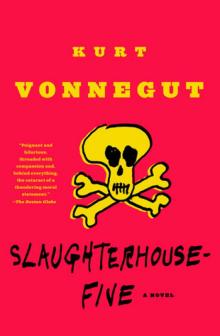 Slaughterhouse-Five
Slaughterhouse-Five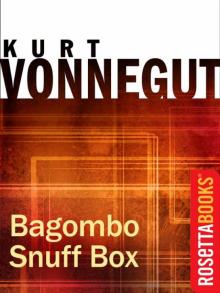 Bagombo Snuff Box: Uncollected Short Fiction
Bagombo Snuff Box: Uncollected Short Fiction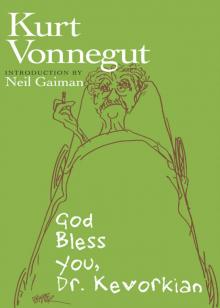 God Bless You, Dr. Kevorkian
God Bless You, Dr. Kevorkian Breakfast of Champions
Breakfast of Champions While Mortals Sleep: Unpublished Short Fiction
While Mortals Sleep: Unpublished Short Fiction Slapstick or Lonesome No More!
Slapstick or Lonesome No More! Cat's Cradle
Cat's Cradle The Sirens of Titan
The Sirens of Titan A Man Without a Country
A Man Without a Country Look at the Birdie: Unpublished Short Fiction
Look at the Birdie: Unpublished Short Fiction Bluebeard
Bluebeard Hocus Pocus
Hocus Pocus The Big Trip Up Yonder
The Big Trip Up Yonder Palm Sunday: An Autobiographical Collage
Palm Sunday: An Autobiographical Collage Jailbird
Jailbird Happy Birthday, Wanda June
Happy Birthday, Wanda June Welcome to the Monkey House
Welcome to the Monkey House Player Piano
Player Piano Fates Worse Than Death: An Autobiographical Collage
Fates Worse Than Death: An Autobiographical Collage Love, Kurt
Love, Kurt Timequake
Timequake God Bless You, Mr. Rosewater
God Bless You, Mr. Rosewater 2 B R 0 2 B
2 B R 0 2 B The Eden Express: A Memoir of Insanity
The Eden Express: A Memoir of Insanity Mother Night
Mother Night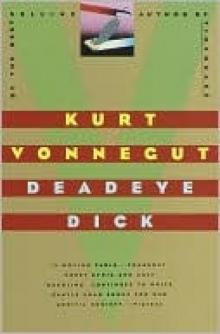 Deadeye Dick
Deadeye Dick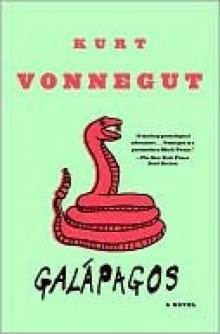 Galápagos
Galápagos Palm Sunday
Palm Sunday We Are What We Pretend to Be
We Are What We Pretend to Be Look at the Birdie
Look at the Birdie Basic Training
Basic Training Armageddon in Retrospect
Armageddon in Retrospect Basic Training (Kindle Single)
Basic Training (Kindle Single) If This Isn't Nice, What Is?
If This Isn't Nice, What Is? Bagombo Snuff Box
Bagombo Snuff Box The Petrified Ants
The Petrified Ants Cat's Cradle: A Novel
Cat's Cradle: A Novel Fates Worse Than Death: An Autobiographical Collage (Kurt Vonnegut Series)
Fates Worse Than Death: An Autobiographical Collage (Kurt Vonnegut Series)